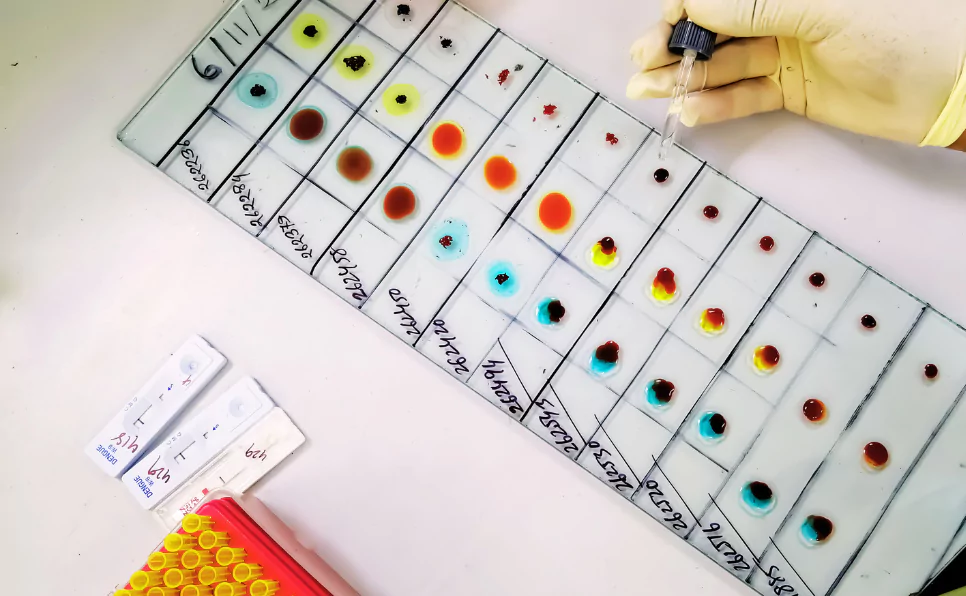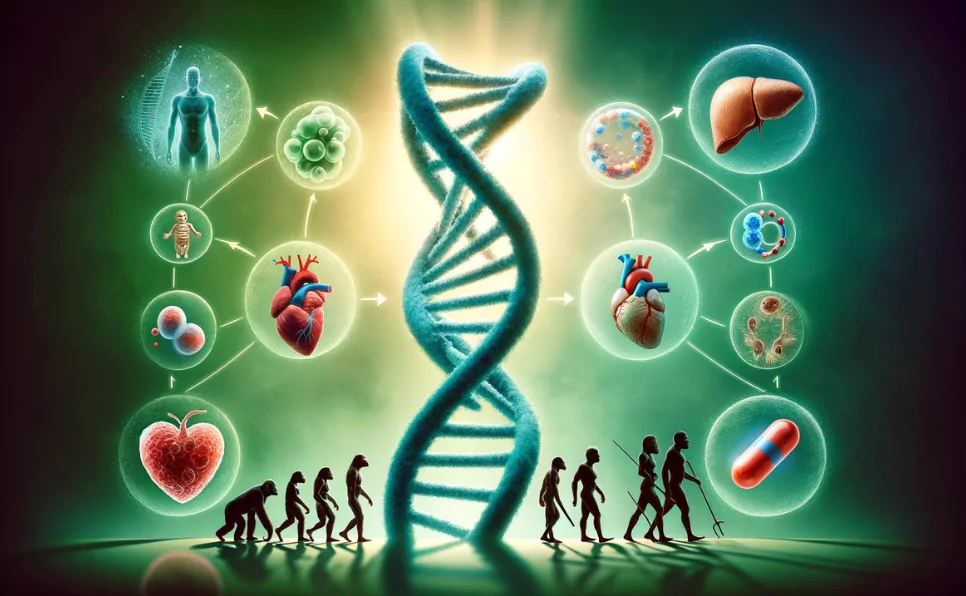When we look back at the journey of human dietary evolution, it’s clear that our ancestors didn’t have the luxury of grocery stores or food delivery services.
They ate what was available – which often meant ingesting plants that weren’t exactly friendly to the human digestive system.
It’s fascinating, then, to consider how we’ve come to be able to eat a wide variety of plants without (for the most part) keeling over. The secret? Genetic adaptations.
Our bodies have evolved in incredibly complex ways to handle what we eat, including those plants that pack a bit of a punch with their natural toxins.
It’s a bit like our internal systems have learned some neat tricks over thousands of years, letting us munch on a wider menu without too many issues.
Key Takeaways
- The ability to digest plant toxins is a result of specific genetic adaptations.
- These adaptations have historical roots but continue to affect modern dietary preferences and health.
- Understanding our genetic predispositions can lead to personalized nutrition plans that cater to our individual dietary needs.
Understanding Plant Toxins
Plant toxins are chemicals that plants produce mainly to protect themselves from pests and diseases.
They’re like the plant’s personal bodyguards.
Some common examples include caffeine (yes, that morning pick-me-up is technically a toxin), solanine in potatoes, and cyanide compounds in almonds and apple seeds.
Historical Interaction Between Humans and Plant Toxins
Our ancestors were pretty adventurous eaters out of necessity.
This means they often encountered these plant bodyguards. Over time, as humans kept nibbling on toxic plants, something remarkable happened.
Our bodies started to adapt. This wasn’t an overnight change but a slow, evolutionary adjustment that allowed our digestive systems to handle and even benefit from these plant toxins.
Genetic Adaptations for Digesting Plant Toxins
Our genetic makeup is like a set of instructions for our body, including how to handle different substances we ingest.
For example, specific enzymes in our bodies are responsible for breaking down toxins, and variations in our genes can affect how well these enzymes work.
Key Genetic Adaptations Over Time
Let’s talk about some cool examples. There’s the ability to metabolize cyanogenic glycosides, found in cassava and almonds, which can be toxic in high amounts but is handled just fine by people with certain genetic adaptations.
And lets not get started on alcohol. The ability to break down alcohol varies greatly across populations, thanks to differences in the ADH1B gene.
These genetic tweaks didn’t just happen.
They gave our ancestors a survival edge, allowing them to exploit new food sources and thrive in different environments.
Our ancestors had a diverse diet, full of plants that were both nutritious and, sometimes, a bit toxic.
Interestingly, over generations, humans have evolved genetically to handle various plant toxins, allowing us to eat a wide range of foods today.
But what does this ancient history mean for us now? It’s fascinating and, frankly, a bit mind-boggling to see how these old genetic tricks are shaping our modern lives, from what ends up on our dinner plates to how we react to different foods.
Evolving Tastes for Safety and Digestibility
We developed ability to recognize and often avoid foods that contain toxins or are indigestible. This skill is not just about the physical processing of foods but also about the sensory detection of potential dangers, a crucial survival tool passed down through generations.
The Role of Taste Receptors
At the forefront of this evolutionary adaptation is our sense of taste.
Humans have a range of taste receptors that are fine-tuned to detect various flavors, including bitterness, which often signals the presence of toxic compounds in plants.
The ability to taste and react to these bitter compounds has been a critical factor in our ancestors’ survival, steering them away from potentially harmful foods.
PTC Tasting: A Genetic Insight into Bitterness Detection
A fascinating example of how genetics plays into our dietary evolution is the ability to taste phenylthiocarbamide (PTC), a compound similar to those found in cruciferous vegetables like broccoli and Brussels sprouts.
The ability to taste PTC (and similar bitter compounds) is controlled by a specific gene variant.
Those with a certain version of this gene find these foods extremely bitter, while others may not taste much at all.
This variation in taste perception is believed to have been an evolutionary advantage.
For some, the heightened sensitivity to bitterness helped avoid potentially toxic plants. For others, not perceiving these plants as overly bitter allowed for a broader diet when food sources were scarce.
Impacts on Contemporary Diets
You might not realize it, but the foods you love or hate, the diet trends you follow, and even the way your body reacts to a slice of pizza versus a bowl of salad are all influenced by genetic adaptations from way back.
Our ancestors’ ability to digest plant toxins has a direct line to our modern dietary choices and health. Here’s a breakdown:
- How ancient genetic adaptations influence modern dietary choices and health: Our love for certain flavors, like bitterness in coffee or chocolate, might come from an inherited tolerance for certain plant toxins. It’s like our taste buds have been trained over millennia to handle and even enjoy these flavors.
- The role of biodiversity in diet and nutrition: Eating a variety of foods is good for us, right? This idea has roots in how our ancestors thrived by eating a diverse range of plants and animals. Our bodies have evolved to benefit from a mix of nutrients, which is a fancy way of saying, “Eat your veggies (and fruits, grains, and proteins)!”
Moreover, the genetic adaptations for taste preferences can shed light on modern health challenges.
For instance, a predisposition to find certain flavors more palatable can influence dietary habits and, by extension, health outcomes.
Genetic Adaptations and Food Sensitivities
Now, this is where things get even more interesting. Ever wonder why some people can’t stand dairy or why gluten becomes the enemy for others? It’s all about our genetic makeup.
- The connection between genetic adaptations and contemporary issues with food sensitivities and allergies: Not everyone has the same set of genetic adaptations, which means our bodies can react differently to the same foods. For some, consuming dairy is no problem, thanks to ancestors who adapted to digest lactose. For others, it’s a no-go. The same goes for gluten and other food components that can cause sensitivities or allergies.
- Gluten intolerance and other sensitivities from a genetic perspective: It’s like our bodies are still playing catch-up with the agricultural revolution. Gluten intolerance, for example, might stem from our bodies not fully adapting to wheat and other grains’ dominance in our diets.
Implications for Personalized Nutrition
The real kicker is how this research could change the game for diet and nutrition. Personalized nutrition isn’t just a fad; it’s the future.
- How understanding genetic adaptations could lead to more personalized dietary recommendations: Knowing your genetic background could help tailor your diet to what your body handles best. It’s like having a custom menu designed just for you, based on your DNA.
- The future of nutrition in light of genetic testing and biotechnology: With advances in genetic testing, we’re getting closer to a world where you can know exactly which foods are your friends and which ones are foes, all based on your genes.
Final Thoughts
Understanding our genetic adaptations for digesting plant toxins isn’t just a cool fact for your next dinner party; it’s a key to unlocking healthier lives.
It reminds us of the incredible journey our species has been on and how the foods we eat are a direct link to that history.
As we look forward, the fusion of genetics, diet, and technology holds the promise of even more personalized ways to eat healthily and live well.
FAQs
Can everyone process plant toxins the same way?
Nope, not everyone can handle plant toxins the same. It’s all about your unique genetic makeup. Some people might be champs at digesting certain plants, thanks to their ancestors’ adaptations, while others might find the same foods a bit troublesome. It’s a genetic lottery!
How do genetic adaptations affect my food choices?
Your genes play a big role in your food likes, dislikes, and how your body reacts to different foods. Thanks to genetic adaptations, you might love certain flavors or be able to munch on dairy without a problem. It’s like your ancestors left you a culinary roadmap!
Are there new genetic adaptations happening now due to our current diets?
Yes, our diets are constantly evolving, and so are our genes, albeit slowly. As we introduce new foods and eating habits, our bodies may begin to adapt genetically over many generations. It’s a slow process, but today’s diet could shape tomorrow’s genetic tweaks.
FAQs
- The plant poisons that shape our daily lives – Nature
- Linking our ancestral diet to modern functional foods as a means of chronic disease prevention – PubMed
- Diet, Polyphenols, and Human Evolution – MDPI Applied Sciences
- Evolution of the Human Diet and Its Impact on Gut Microbiota, Immune Responses, and Brain Health – MDPI Nutrients

Dr. Sumeet is a seasoned geneticist turned wellness educator and successful financial blogger. GenesWellness.com, leverages his rich academic background and passion for sharing knowledge online to demystify the role of genetics in wellness. His work is globally published and he is quoted on top health platforms like Medical News Today, Healthline, MDLinx, Verywell Mind, NCOA, and more. Using his unique mix of genetics expertise and digital fluency, Dr. Sumeet inspires readers toward healthier, more informed lifestyles.





